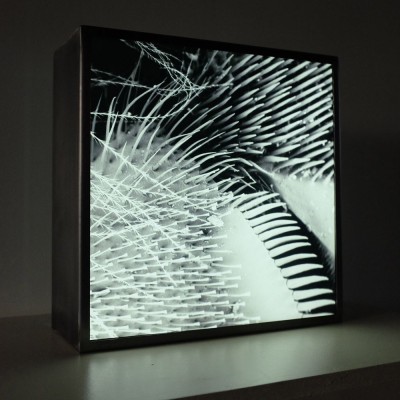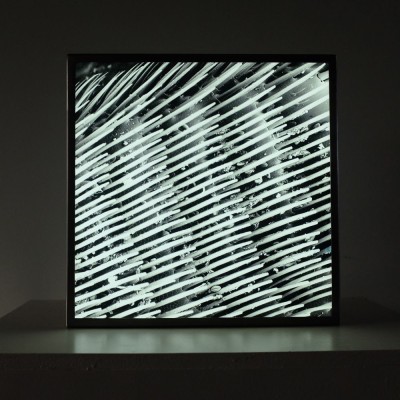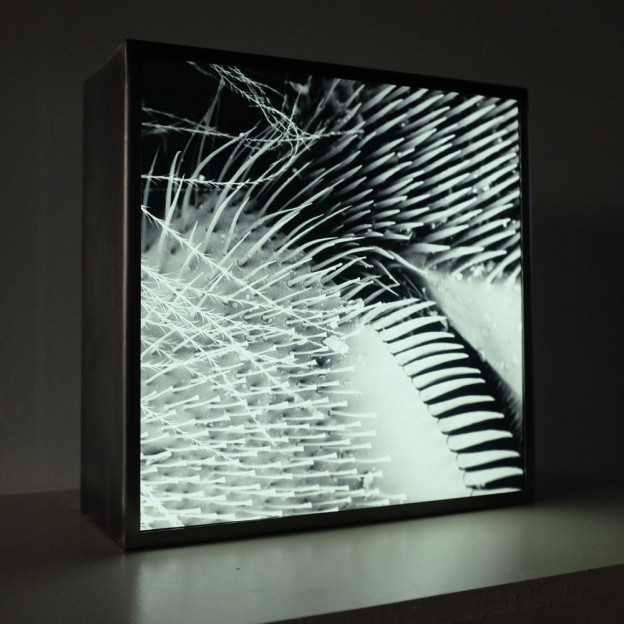The work is a series of 8 lightboxes, representing microscopical photographs of bee-parts and pollen grains. The photos are made with the high-end Scanning Electron Microscope (SEM), which is used for scientific research and can display greatly enlarged images of objects, also in 3D view. The study (in collaboration with scientists from the VUB) lead to a remarkable series of microscopical photographs. Honeybee parts (proboscis, antennae, legs, eyes) as well as pollengrains the bees brought back from their foraging flights, were closely inspected.
On one picture we see a ‘pollen comb’, enlarged 275 times. This is situated on the back leg and serves to push the pollen that the bee collects on flowers into the pollen case. In this way the bees can transport the pollen to their nest. Another picture shows a ‘joint’ (enlarged 490 times) that connects the different limbs of the leg. All photos show that bees are covered with hairs in many thicknesses. These hairs are electrostatically loaded and have multiple functions. The pollen attach themselves easily to them, facilitating in this way the cross-pollination during the bee’s visit to the flowers. The hairs also act as sensors.
Since 2009, Maes’ develops artistic works based upon her research that she is carrying out by means of observation beehives. The hives are enhanced with microphones which pick up the vibrations and sounds of the bee colonies. Cameras inside the hive monitor the growth of the wax structures and the activity in the colony. Additional sensors measure temperature, humidity and other microclimate measures inside and outside the beehive. AnneMarie Maes created an extensive rooftop garden in the centre of Brussels, which hosts the experimental beehives and instrumentation equipment. From this laboratory, data is continuously being broadcast through streaming technology.




Lightboxes – SEM photographs.
Brushed steel case, duratrans prints, plexi, led lights and transfo, 26cm x 26cm x 10cm.
From Left to right, clockwise: Bees, Pollen Comb – Bees, Receptors – Bees, Eye – Bees, leg.
The Brussels Urban Bee Lab, founded by AnneMarie Maes, is an independent international collective of artists, scientists, beekeepers, technicians and creative people. The BUBL uses artistic, scientific and technological research approaches to tackle challenges related to sustainability and the monitoring and survival of city honeybees. Bee colonies are currently threatened in Europe at an alarming rate and BUBL’s research is therefore of great importance, both by raising awareness and by providing unprecedented data for studying bee colony collapse disorder.
The Brussels Urban Bee Lab operates mainly through artistic installations and workshops. The lab has already produced several very original beehives and produced art works shown in international exhibitions. The installations explore highly experimental technologies, such as microbial fuel cells, digital and organic fabrication using Open Structures, biomimicry, spatialised sonification, web-based continuous data streaming, data mining based on Artificial Intelligence, organic electronics, solar energy for powering low-energy computing, etc. The lab collaborates with universities and other artistic research centers throughout Europe.
AnneMarie Maes (or Annemie Maes) – Brussels, 1955 studied a masters in fine arts at the Luca School of Arts in Brussels, a masters in cultural studies at the University of Brussels, and a specialisation in anthropological documentary film at the Institute for Sound Image Culture in Brussels.
She has for decades been a recognized leader pioneering art-science projects in Belgium, using highly original ways to bring out hidden structures in nature by constructing original technological methods to probe the living world and by translating that in artistic creations through sonification, visualization, sculptures, large-scale long-term installations, and workshops. She thus makes use of technological mediation to search for new forms of communication with the natural world.
In 2007 Annemie Maes co-founded the artist collective OKNO which has been active on the border between new media and ecology. OKNO uses DIY and collective artist practices to find new ways to engage with the urban environment. In 2009 she founded the Brussels Urban Bee Lab as a spin-off from OKNO. It focuses on urban bee colonies as a vehicle for novel artistic practices to raise ecological awareness.
AnneMarie Maes has exhibited widely in international contexts, including in various European countries (Austria, Belgium, Croatia, Finland, France, Germany, Spain, Sweden, etc.) as well as the US (New York), Syria, India and Brazil.
More information on the BEE-research is available browsing the BEE Notebooks and downloading the Foraging Fields booklet.
keywords: beekeeping, ecology, networks, data-visualisation and sonification, pollen analysis, rooftop gardening, urban agriculture, accidental nature, politics of green spaces.
———————————————
The lightboxes are part of the collection of:
– the LIEDTS foundation (Mr. A. Liedts) (bee leg & bee pollen comb)
– Jerome Collet and Sofie Vandermarliere (bee eye & bee receptors)
– Caroline Dedeyne-Despriet (bee eye & bee receptor, bee leg & bee pollen comb)
———————————————
BEE POLLEN COMB and BEE LEG (2013) by Annemarie Maes
http://www.zebrastraat.be/cultuur.html – permanent collection
Voor de foto’s is er gewerkt met de bijen van het Brussels Urban Bee Lab (BUBL) waar nieuwe media kunstenaar Annemarie Maes de oprichter en drijvende kracht van is. De foto’s werden door AnneMarie Maes gemaakt aan de VUB (Vrije Universiteit Brussel) met een Scanning Electron Microskoop. Deze professionele microskoop wordt gebruikt voor wetenschappelijk onderzoek en kan objecten sterk vergroot en in 3 dimensioneel zicht weergeven.
Op de linker foto zien we een ‘pollen kam’, 275 keer vergroot. Deze kam bevindt zich op de achterpoot van de bij en dient om de op de bloemen verzamelde pollen in het pollendoosje, dat zich eveneens op de achterpoot bevindt, te proppen. Op deze manier kunnen de bijen de pollen -die het proteïne-gehalte vormen in het bijendieet- transporteren naar hun nest.
Op de rechter foto zien we een ‘gewricht’ (490 x vergroot) dat verschillende ledematen van de achterpoot verbindt. Beide foto’s tonen dat bijen bedekt zijn met donshaartjes in verschillende diktes. Deze haartjes zijn electrostatisch geladen en hebben verschillende functies. Enerzijds hechten de pollen zich er makkelijk aan vast, waardoor de bij aan kruisbestuiving doet bij haar bezoek aan verschillende bloemen. Anderzijds fungeren de haartjes als sensoren voor de bij om zich te orienteren.
AnneMarie Maes is mede-oprichter van het kunstenaarscollectief OKNO dat actief is op de grens tussen nieuwe media, technologie en ecologie. In 2009 richtte zij het Brussels Urban Bee Lab op als een spin-off van OKNO. Het BUBL werkt met stedelijke bijenkolonies als vehikel voor onderzoek naar nieuwe artistieke praktijken en ter bevordering van ecologische bewustmaking. AnneMarie Maes benadert planten als individuen in interactie met bijen, en de aanwezigheid van de technologie als een sociale werkelijkheid.
Bijen kolonies worden momenteel op alarmerende wijze bedreigd in Europa. BUBL maakt gebruik van artistieke, wetenschappelijke en technologische onderzoeksmethodes om de uitdagingen met betrekking tot het welzijn en voortbestaan van de stedelijke honingbijen op een duurzame wijze te verbeteren.
Het Brussels Urban Bee Lab communiceert voornamelijk via artistieke installaties en workshops. De groep produceert tal van kunstwerken die participeren in internationale tentoonstellingen, en werkt samen met universiteiten en andere artistieke research centra in Europa. Het Brussels Urban Bee Lab heeft haar field lab in een grote daktuin in het centrum van Brussel. Daar wordt geexperimenteerd met verschillende observatie bijenkasten die uitgerust zijn met allerhande meetapparatuur. Vanuit dit laboratorium worden data continu online ter beschikking gesteld via streaming technologie.
—–
Annemarie Maes a travaillé avec les abeilles de la Brussels Urbain Bee Lab (BUBL), dont elle est la fondatrice et le moteur. Les photos qu’elle a réalisées à la VUB le sont avec un microscope électronique à balayage, utilisé dans la recherche scientifique et qui permet d’agrandir considérablement des objets et de les représenter dans une vue 3D. Sur la photo de gauche, nous voyons un « peigne à pollen », agrandi 275 fois. Ce peigne, situé sur les pattes arrière de l’abeille, sert à rassembler dans une sorte de bôite les pollens récoltés sur les fleurs, ce qui permet leur transport vers la ruche. La photo de droite montre une ‘articulation’ (agrandie 490 fois) reliant les différents éléments de la patte arrière. Les deux photos montrent que les abeilles sont recouvertes de poils d’épaisseur variable. Ceux-ci sont chargés électrostatiquement et ont des fonctions multiples. Les grains de pollen s’y attachent facilement permettant ainsi la pollinisation croisée lorsqu’une abeille visite une fleur. Ces poils ont égale-ment une fonction sensorielle.
Annemarie Maes est co-fondatrice de Pix & Motion (1985-2000), un atelier de film d’animation expérimental qui a imposé sa propre marque artistique sur le monde des vidéoclips musicaux. Elle a fondé les organisations Looking Glass (1997-2004) et OKNO (°2004), et joue un rôle de premier plan sur la scène de l’art multimédia à Bruxelles, en réunissant des artistes dans des ateliers et laboratoires de recherche. Les projets multimédias de Maes font se mêler les perspectives écologiques, sociales et anthropologiques.
Annemarie Maes worked with the bees of the Brussels Urban Bee Lab (BUBL), of which she is the founder and driving force. She made the photos at the VUB with a Scanning Electron Microscope, which is used for scientific research and can display greatly enlarged images of objects, also in 3D view. On the left picture we see a ‘pollen comb’, enlarged 275 times. This is situated on the back leg and serves to push the pollen that the bee collects on flowers into the pollen case. In this way the bees can transport the pollen to their nest. The right picture shows a ‘joint’ (enlarged 490 times) that connects the different limbs of the leg. Both photos show that bees are covered with hairs in many thick-nesses. These hairs are electrostatically loaded and have multiple functions. The pollen attach themselves easily to them, facilitating in this way the cross-pollination during the bee’s visit to the flowers. The hairs also act as sensors.
Maes is co-founder of Pix & Motion (1985-2000), an experimental animated film studio that pressed its own artistic stamp on the music video culture. She founded the organizations Looking Glass (1997-2004) and OKNO (° 2004) and plays a prominent role in the Brussels multimedia art scene by bringing together artists in workshops and research laboratories. In Maes’ multimedia projects, the ecological, social and anthropological perspectives are interwoven.
